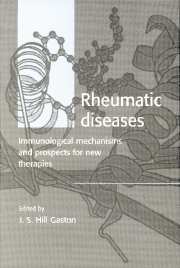Book contents
- Frontmatter
- Contents
- List of contributors
- 1 Implications of advances in immunology for understanding the pathogenesis and treatment of rheumatic disease
- 2 The role of T cells in autoimmune disease
- 3 The role of MHC antigens in autoimmunity
- 4 B cells: formation and structure of autoantibodies
- 5 The role of CD40 in immune responses
- 6 Manipulation of the T cell immune system via CD28 and CTLA-4
- 7 Lymphocyte antigen receptor signal transduction
- 8 The role of adhesion mechanisms in inflammation
- 9 The regulation of apoptosis in the rheumatic disorders
- 10 The role of monokines in arthritis
- 11 T lymphocyte subsets in relation to autoimmune disease
- 12 Complement receptors
- Index
4 - B cells: formation and structure of autoantibodies
Published online by Cambridge University Press: 06 September 2009
- Frontmatter
- Contents
- List of contributors
- 1 Implications of advances in immunology for understanding the pathogenesis and treatment of rheumatic disease
- 2 The role of T cells in autoimmune disease
- 3 The role of MHC antigens in autoimmunity
- 4 B cells: formation and structure of autoantibodies
- 5 The role of CD40 in immune responses
- 6 Manipulation of the T cell immune system via CD28 and CTLA-4
- 7 Lymphocyte antigen receptor signal transduction
- 8 The role of adhesion mechanisms in inflammation
- 9 The regulation of apoptosis in the rheumatic disorders
- 10 The role of monokines in arthritis
- 11 T lymphocyte subsets in relation to autoimmune disease
- 12 Complement receptors
- Index
Summary
Introduction
Many autoimmune diseases are characterized by production of autoantibodies, and detection and measurement of these antibodies in patients' sera is used in diagnosis and monitoring of disease. For some autoantibodies, such as antibodies to double-stranded DNA (dsDNA) in SLE, or anti-acetylcholine receptor antibodies in myasthenia gravis, the autoantibodies appear to be involved in pathogenesis. Until recently, investigation in patients has been restricted largely to the mixed antibody populations in serum. However, using hybridoma and molecular biological technology, it is now possible to dissect out the individual antibodies from patients' sera and analyse specificity and molecular structure. By combining cloned and sequenced antibodies with the increasingly defined autoantigens, we are gaining insight into the features of autoantibodies that are responsible for pathogenicity. This review will describe our current understanding of antibody structure and the immunoglobulin (Ig) genes that encode the binding sites of autoantibodies. Knowledge at the genetic level may offer therapeutic opportunities based on rational design in order to block pathogenic interactions.
Variable region genes
V gene recombination
The events occurring in immunoglobulin genes during maturation of a B cell from a pro-B cell to a fully differentiated plasma cell are shown in Fig. 4.1. The genes encoding the heavy chains of immunoglobulin are highly unusual in having three separate genetic elements that must be combined prior to transcription (Tonegawa, 1983). Recombination takes place in two steps and is initiated by the lymphoid-specific RAG1 and RAG2 proteins (Gellert, 1992).
- Type
- Chapter
- Information
- Rheumatic DiseasesImmunological Mechanisms and Prospects for New Therapies, pp. 61 - 78Publisher: Cambridge University PressPrint publication year: 1999



